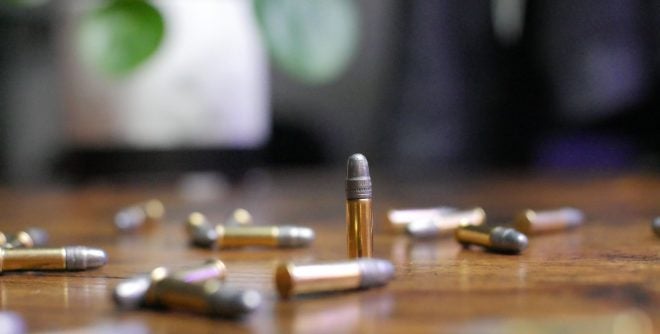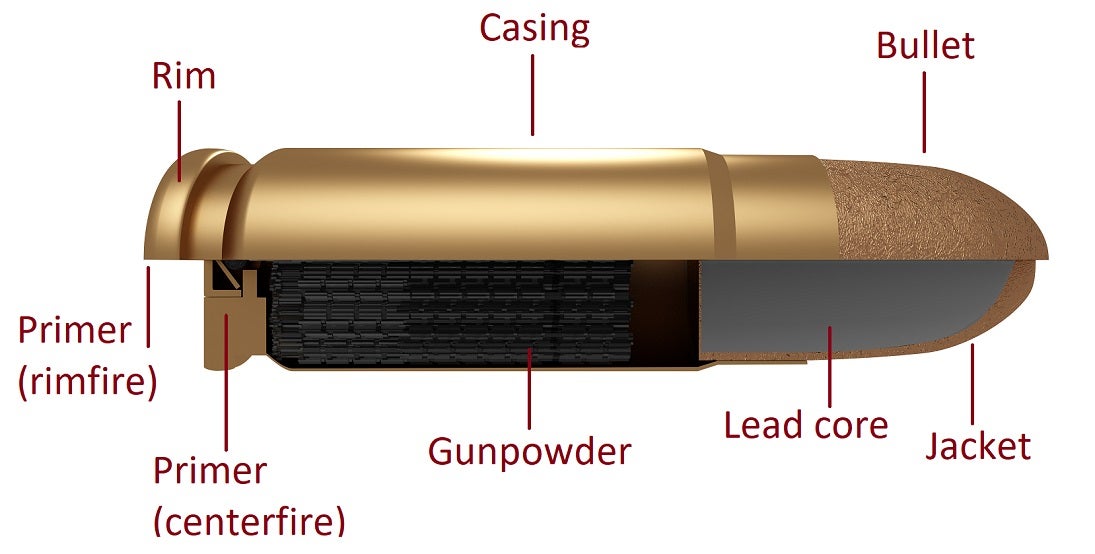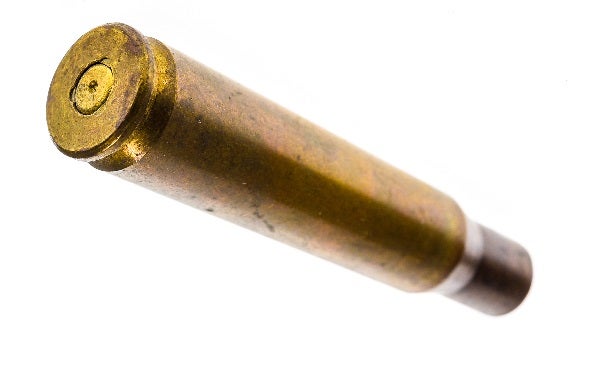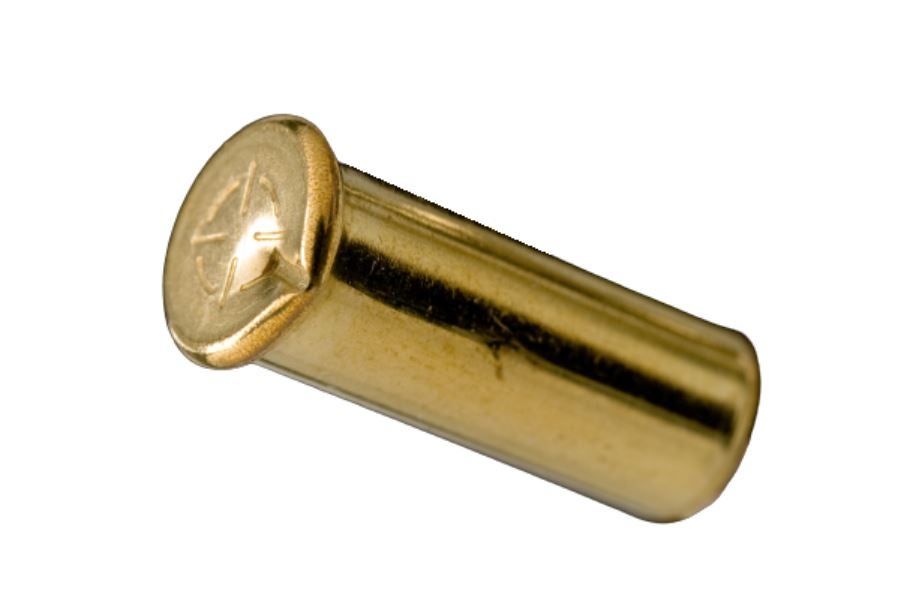Rimfire vs. Centerfire Ammo Explained
Travis Olander 03.14.23

The method used to make ammo “go boom” is divided into two categories: Rimfire and centerfire primers. As a new shooter, you might’ve first shot a .22 LR-chambered rifle or handgun, which is a rimfire cartridge. What’s the difference between it, and a centerfire cartridge? Let’s explain.
Parts of Typical Ammo Cartridges
Whether rimfire or centerfire, all modern firearm ammunition is constructed as below:

In this example, we’re looking at a typical full-metal-jacket (FMJ) handgun cartridge. Rifle and shotgun cartridges are built the same way. The base of the shell casing houses the primer, which is located either in the center of the casing (for centerfire ammo) or within the rim itself, for rimfire. This is obviously how both cartridge primers get their names.
For either cartridge to function, the firing pin must strike the primer. This causes the primer to ignite, creating a spark that then ignites the gunpowder inside the casing. The rapidly expanding gas created by the burning gunpowder propels the bullet down the barrel, causing it to gain velocity before exiting the muzzle.
Centerfire Cartridge After Ignition
In centerfire ammunition, the primer is a separate mechanism that must be seated within a circular recess in the center of the base of the shell casing. Think of a centerfire primer as a tiny explosive device. On the spent rifle shell casing pictured above, you can see the dimple left in the primer where the firing pin struck.
Rimfire Cartridge After Ignition
In rimfire cartridges, the primer is built into the rim of the shell casing itself. Pictured here is a spent .22 LR casing. You can see the indentation left on the edge of the rim where the firing pin struck to ignite the gunpowder inside.
Centerfire vs. Rimfire: Pros and Cons
Now you know how each cartridge works. But what’s the point of either one? Let’s compare pros and cons.
Rimfire Pros
It’s super cheap.
Rimfire ammunition is incredibly affordable, which is a great reason to buy a rimfire firearm in the first place – especially since ammunition prices have skyrocketed in the past few years. For the price of 20 centerfire rifle cartridges, you can typically afford around 100 to 200 rimfire cartridges and enjoy a day at the shooting range just as well.
It’s low-recoil.
Rimfire ammunition uses much less gunpowder than centerfire cartridges, and they’re typically limited to .22-calibers or smaller. This makes rimfire ammo perfect for first-time gun owners, young shooters, and those who are interested in firearms but feel intimidated about shouldering a big rifle, or handling a centerfire handgun or shotgun.
It’s relatively quiet.
We’ve talked quite a bit about how important hearing protection is. Centerfire ammunition is often loud enough to cause permanent hearing loss with just a single shot fired. Although rimfire ammunition can still be dangerous to your hearing, it’s quieter by an order of magnitude. Some rimfire cartridges can be safely fired with no hearing protection and minimal to no risk of hearing damage. Add a suppressor, and you’ll barely hear the shot over a quiet conversation.
It’s surprisingly accurate.
Although rimfire ammo seems primitive in its design, it’s just as accurate as any centerfire cartridge. With a quality rimfire rifle like a Ruger 10/22, you can easily place one shot directly in the hole of your last, up to 50 to 100 meters. Some long-range rimfire rifles with match barrels are capable of sub-MOA accuracy at even greater distances.
Rimfire Cons
It’s not as reliable.
Rimfire cartridges are more likely to suffer light strikes and not ignite, giving you a dud in the chamber. It’s a simple matter of rechambering the next round, but it can certainly be annoying. Always invest in well-known rimfire ammo to ensure high reliability.
It can’t be reloaded.
Since the primer is built into the rimfire casing, these shells are one-time-use only. Many enthusiast shooters and long-range marksmen enjoy reloading for its consistency and cost savings. Although rimfire’s cheap, you can’t reload it.
Rimfire’s low recoil means low power, too.
If you want to hunt deer or you’re investing in a firearm for self-defense, you’ll need centerfire cartridges. Rimfire cartridges are only instantly lethal against varmint and small game. They can’t be loaded for higher power because their casings need to be thin enough for the firing pin to ignite the primer in the rim. This prevents rimfire casings from being able to withstand high pressure.
While rimfires are technically lethal against large targets at close range, the chances are high that you won’t take down an aggressor or large animal with even multiple shots, unless the shots are well placed in critical areas.
Centerfire Pros
It’s more accurate at distance.
Although rimfire allows even novice shooters to achieve sub-MOA groups within 100 meters or so, some centerfire cartridges can accomplish the same feat at 500 meters or more. Match ammunition is capable of high accuracy as far as 1,000 meters downrange.
It has (much) more power.
The most powerful centerfire cartridges can take out large African game with a single hit, and every virtually rifle or handgun made for self-defense and competition is chambered with centerfire rounds. Since centerfires use a standalone primer, their casings can be thicker. They’re capable of containing much higher pressures, which is necessary to produce more velocity and power with heavier bullets.
It’s easily reloadable.
Unlike rimfire, reloading centerfire cartridges is not only possible, but surprisingly easy for most calibers: Clean the spent casing, seat a new primer, fill the casing with gunpowder, press a new bullet into the neck of the casing, crimp it shut, and you’re ready to fire. Long-range shooters often reload to get exacting performance with high consistency.
It’s often more reliable.
Centerfire primers don’t rely on the thickness of the casing to reliably ignite. The hammer or striker springs and firing pins in centerfire weapons also typically strike much higher force, guaranteeing proper ignition virtually every time. Light strikes only occur in centerfire weapons when there is a mechanical failure or poorly seated primer, both of which are exceedingly rare.
The options are nearly endless.
Since centerfire casings aren’t limited to specific designs by their rim thickness and primers, they can be chambered in literally hundreds of calibers.
Centerfire Cons
It’s not always for beginners.
Centerfire cartridges are loud and produce high recoil, and the weapons they’re chambered in are always heavier, longer, and more difficult to manage. If you’re new to firearms, we always recommend starting with rimfire cartridges. Their low power and sound signature allow you to focus on firearm safety, getting familiar with how a firearm generally functions, and becoming comfortable with the fundamentals of marksmanship. Decades of shooting instruction have proven that starting off with these less intimidating cartridges always allows for better training and confidence-building.
It’s more expensive.
Centerfire ammo costs anywhere from two to twenty times that of average rimfire ammo. At the time of this publication, the common .22 LR costs around $0.12 per round. At this price, you can hit the gun range for hours for quite literally a few dollars. The most common centerfire rifle ammo (the AR-15’s .223 Remington) averages about $0.50 per round. Even the most expensive, power, and accurate rimfire (.22 WMR) goes for just $0.35 to $0.50 per round. This round is more powerful than some handgun ammunition. Some high-performance centerfire rounds cost anywhere from $2.50 to $5.00 each.
It’s more difficult to manage recoil and accuracy.
Many centerfire cartridges are relatively easy to manage, but for new shooters, even a .223 Remington can provide a certain intimidation factor that can inhibit accuracy and confidence. Some larger centerfire rounds are powerful enough to cause injury if recoil isn’t managed properly. To be clear, we’re not saying these are reasons to avoid centerfire rounds at all. The goal for most shooters is to graduate to larger calibers. But this is why we recommend pulling your first few triggers on a rimfire rifle or handgun.
Popular Rimfire Ammo
Ready to get into shooting cheap, fun, quiet ammo? Here are the most popular rimfire loads you should consider, especially if you’re starting out in the shooting sports.
.22 Long Rifle (LR)
.22 LR is easily the most popular rimfire round on the market today. It’s been around since the late 1800’s and remains one of the go-to rounds for new and youth shooters, and those who enjoy a simple day of plinking targets without breaking the bank. It’s perfect for hunting small game, pests, and varmint
- Muzzle velocity: 1,200 to 1,640 FPS
- Muzzle energy: 131 to 191 lb.-ft.
- Optimal twist: 1:16
.22 Short
Pre-dating even .22 LR, the .22 Short is a rimfire handgun cartridge developed in 1957. It was developed for self defense in pocket pistols and mini-revolvers. Considering its lack of power, it’s only true use is found in close-range target and practice shooting. It was the round of choice for the Olympics 25-meter rapid fire pistol event until 2004. This cartridge’s casing is also used to fire the blanks in starter pistols and for powering actuated nail guns.
- Muzzle velocity: 830 to 1164 FPS
- Muzzle energy: 44 to 87 lb.-ft.
- Optimal twist: 1:20
.22 WMR
The .22 Winchester Magnum Rimfire (WMR) or simply “.22 Mag” is arguably the fastest and most powerufl .22-caliber rimfire load. It’s the only .22 rimfire successfully introduced in the 20th century and packs about as much power as some centerfire rounds. It often attracts handload enthusiasts who enjoy high-performance rimfire ammo. The casing can easily take a .22-cal centerfire bullet, which tends to retain more power and accuracy at greater distances.
- Muzzle velocity: 1,530 to 2,300 FPS
- Muzzle energy: 300 to 324 lb.-ft.
- Optimal twist: 1:16
.17 HMR
Think of the .17 Hornady Magnum Rimfire as a faster, lighter .22 WMR. It trades about 17% to 20% muzzle energy for substantial gains in velocity and maximum effective range. Introduced by Hornady in 2004, this Magnum Rimfire is based on the .22 Magnum. It’s necked down while retaining almost identical overall length and max pressure with a skinnier bullet.
Quick Recap
In a hurry? Here’s the gist when comparing rimfire and centerfire ammo:
- Rimfire ammunition uses a primer built into the rim of the casing itself.
- Centerfire ammo uses a standalone primer seated in the base of the casing.
- Rimfire ammo is not reloadable, but it’s cheap, accurate, and quiet with low recoil.
- Centerfire ammo is more expensive but it’s reloadable and provides much more power.
- Most all rimfire ammo is .22- and .17-caliber, limited in power by its thin casing material.

